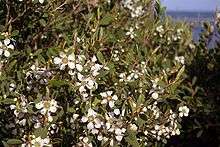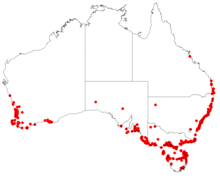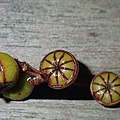Leptospermum laevigatum
| Coastal tea tree | |
|---|---|
 | |
| Scientific classification | |
| Kingdom: | Plantae |
| Clade: | Angiosperms |
| Clade: | Eudicots |
| Clade: | Rosids |
| Order: | Myrtales |
| Family: | Myrtaceae |
| Genus: | Leptospermum |
| Species: | L. laevigatum |
| Binomial name | |
| Leptospermum laevigatum | |
 | |
| Occurrence data from AVH | |
| Synonyms | |
|
Fabricia laevigatum, Fabricia myrtifolia | |
Leptospermum laevigatum, commonly known as the coastal tea tree, is a woody shrub or small tree of the myrtaceae family native to eastern Australia.
Description
The shrub or tree typically grows to a height of 1.5 to 6 metres (5 to 20 ft). It blooms between April and October producing white-pink flowers.[1] It can have the habit of a large, bushy shrub or as low tree with twisted branches.[2]
The bark is mostly smooth[3] but more mature stems have thin brown bark that sheds in long strips.[4] The small leathery[4] grey-green leaves have an oblong to obovate or oval shape and are 10 to 15 millimetres (0.39 to 0.59 in) in length. The leaves have three inconspicuous veins and a blunt tip. When it flowers over winter it produces an inflorescence with flowers that are often solitary in axils. The white flowers with a diameter of around 15 to 20 mm (0.59 to 0.79 in) have five spreading white petals with 20 to 30 stamen. Following flowering it will produce woody fruit with diameter of 7 to 8 mm (0.28 to 0.31 in) with 8 to 10 valves.[3]
The seeds can be dispersed by wind and water.[4]
Taxonomy
The full name for the species is Leptospermum laevigatum (Gaertn.) F.Muell.[5]
The species was first formally described under the current name by the botanist Ferdinand von Mueller in 1858 as part of the work Catalogue of the plants under cultivation in the Melbourne Botanic Garden. Victoria - Parliamentary Papers- Votes and Proceedings of the Legislative Assembly. The species was previously known as Fabricia laevigata by Joseph Gaertner who described in plant is 1788 in the work De Fructibus et Seminibus Plantarum.[6]
Distribution
The natural range of the plant is in south-eastern Australia; the coastal areas of New South Wales, eastern Victoria and north-eastern Tasmania.[4]
The Coastal Tea Tree is now found in all states and territories of Australia with the exception of the Northern Territory, although is considerable prominent throughout the South-East Coastline of Australia, see Atlas of Living Australia for distribution. As a highly invasive species it is found in other countries and parts of the world.[7]
Ecology
Salt-resistant and very hardy, it is commonly used in amenities plantings and coastal plantings. It has also been planted in Western Australia where it has become a weed.[8] This species has been planted along the Central Coast of California in the United States to stabilize sand.[3] It is known there as the Australian tea tree.[9]
It has now become naturalised in New Zealand, southern Africa, California and Hawaii.[4]
The larvae of Holocola thalassinana feed on Leptospermum laevigatum.[10]
Cultivation
L. laevigatum is planted widely as a garden ornamental or display tree. It is useful as a windbreak or hedging plant and for the rapid stabilisation of sandy soils, and in rehabilitation areas where construction or mining has taken place.[4]
 flower
flower fresh fruits
fresh fruits.jpg) Mature seed capsule
Mature seed capsule
References
| Wikimedia Commons has media related to leptospermum laevigatum. |
| Wikispecies has information related to leptospermum laevigatum |
- ↑ "Leptospermum laevigatum". FloraBase. Western Australian Government Department of Parks and Wildlife.
- ↑ "Leptospermum laevigatum". Specialty Trees. Retrieved 20 August 2018. Coastal Tea Tree
- 1 2 3 "Jepson Manual Treatment". Regents of the University of California. Retrieved 20 August 2018.
- 1 2 3 4 5 6 "Fact Sheet Index". Weeds of Australia. Queensland Government. Retrieved 20 August 2018.
- ↑ "Leptospermum laevigatum (Gaertn.) F.Muell". Australian Plant Name Index (APNI), IBIS database. Centre for Plant Biodiversity Research, Australian Government.
- ↑ "Leptospermum laevigatum (Gaertn.) F.Muell. Coastal Tea Tree Names and Sources". Atlas of Living Australia. Global Biodiversity Information Facility. Retrieved 20 August 2018.
- ↑ "'Leptospermum laevigatum (Gaertn.) F.Muell. Coastal Tea Tree". Atlas of Living Australia. Global Biodiversity Information Facility. Retrieved 20 August 2018.
- ↑ Australian Weeds Committee. "Weed Identification - Coastal Tea Tree". National Weeds Strategy. Archived from the original on 2006-08-30. Retrieved 2007-07-18.
- ↑ "Leptospermum laevigatum (Sol. ex Gaertn.) F. Muell. Australian teatree". USDA. Retrieved 20 August 2018.
- ↑ tortricid.net. "Holocola".